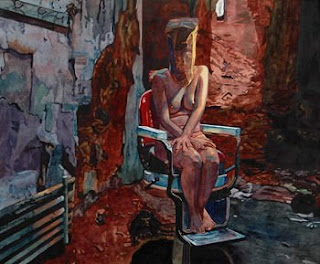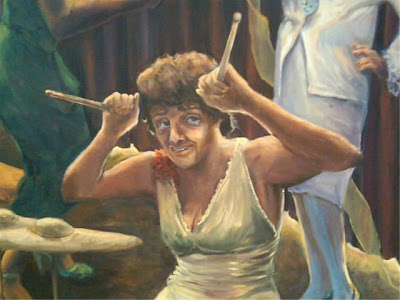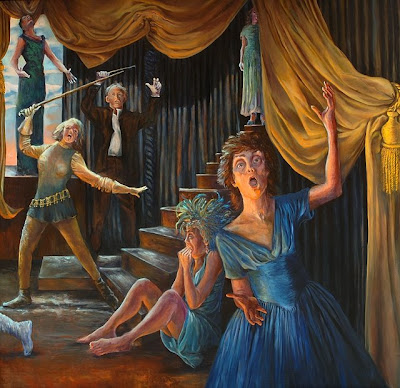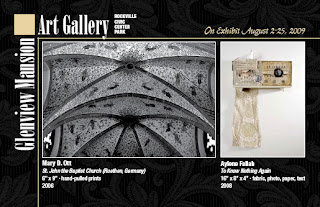Mellema on the Torpedo Factory
My good friend Kevin Mellema, the art critic for the Falls Church News-Press, and one art critic who really gets around all the galleries in the DC area, has the following to say on the issues discussed here.
... As for the Torpedo Factory situation... All I know about it is what I just read on your blog. So I can't make any definitive comments about what has, or is likely to happen based on any inside info, etc.And then a second set of thoughts from Kevin:
I must say, that I'm hesitant to speak up at all. This is one of those thankless situations where you can make few friends, and a lot of enemies fast. Having said that I'll toss in my two cents worth on a general level. Maybe some of this will help the process..
I whole heartily agree with you on your comments about the Target Gallery within the Torpedo Factory. My beat being based in Northern Virginia, Target Gallery is one of five or six key venues that I try to cover on a regular basis. After that I get to travel around the area and cover other venues.
The Target Gallery regularly hosts international open call shows. Due to shipping costs and the like, they're functionally national shows with maybe one or two small international pieces thrown in. I don't know of anybody else in the entire DC metro area who is doing this. Virtually every other open call show in the area concentrates on the DC metro area, or if they get really open minded about it, the Mid-Atlantic region. Which is fine, but you know that there is valid art being made outside of a 200 mile radius from the Capitol Building. It seems to me that the art world in DC has taken on a bit of that 'inside the Beltway' blinkered viewpoint that DC is known for politically.
DC regularly gets sandpapered when some journalist writes about the fashion vacuum in DC. They stop just short of saying we're all dressed by LL Bean, or J. Crew. You could say DC is intellectually, and stylistically, a 'safe' town. People who work for the government don't particularly like having their political view points known. Keeping in mind that the government, traditionally speaking, has been the main employer in town. Some days I look around while driving, and it seems like they don't make vinyl siding in any color besides beige.
In short, DC can in many ways create it's own beige bubble. I may be alone in this view point, but I see some of that in the arts community around town as well. The one absolute exception being the Target Gallery. If you get around town enough you'll see the same 100 or 200 folks reconfigured in show after show after show. You walk into the Target Gallery and if you're really up on everybody in town you might pick up on one or two local artists, and the rest will be completely new to you... and likely never to be seen again.
For what is essentially a tiny gallery space, the Target Gallery is doing a magnificent job.
What goes on around the Target Gallery, within the Torpedo Factory, is the polar opposite of that. The Art League puts on an endless series of member shows, with the core room dedicated to featured solo exhibitions.
The artists out in the studio spaces seem to never change at all. I know they change, but for the most part it's imperceptible. The artists at the Torpedo Factory are in effect running small stores. In many ways the facility has more in common with Tyson's Corner Mall than probably any of us would be comfortable admitting to.
I poke my head into some of the stalls from time to time. It often seems as though I've seen it all before. Painting the same picture over and over again, as you said. Which is not to say that some of these folks aren't doing fabulously skilled work. However it is commercial work almost universally geared to sell to tourists, and I would imagine interior decorators. 'Blood and Guts' art it is not.
I can distinctly recall asking one artist if they showed anywhere else. The response was a rather gruff no. Elaborated on by pointing out that to do so would mean having to give up half their profit to someone else. Valid point taken. Distinct disinclination to experiment, expand their horizons, etc. also duly noted.
The Torpedo Factory is a very safe environment for artists, who generally speaking turn out safe art which anyone would be comfortable hanging on their dining room wall. All fine to a point. But too much of one thing makes for a boring scene.
I'm a big believer in artistic cross pollination. I think the process feeds on new ideas and view points. I don't see that happening there.
I'd support some degree of shake up at the Torpedo Factory. I think it would be good for them, and good for the DC arts community at large. I don't want to see people tossed out on their can, but some middle ground seems worth seeking out. Old Town Alexandria isn't exactly the edgiest part of the Metro area. Can they really hack having 'blood and guts' artists in there?? As you've pointed out, it's a can of worms.
Art Whino seemed to be doing OK on St. Asaph Street a dozen or so blocks a way, before they moved. Then again, that was safely away from the waterfront area.
People who seek out pithy art tend to avoid the Torpedo Factory. It's one reason I keep hammering on the notion that the Target Gallery really is one of the best gallery venues in town.
As for ink jet prints, by whatever name... I must say that when it comes to color photography, in many ways the computer prints exceed the quality of traditional wet bath prints.
A) Color prints have a notoriously short life span. You hear all sorts of numbers thrown around, and it always depends on light exposure, humidity, and temperature... but 20 years is about it for a C print. Archival computer prints are now claiming 100+ years.
B) Photo images tend to get nastier and nastier the bigger you make them. Where as computer interpolation software can hold resolution as the print size grows. Suddenly big prints have the crispness of smaller ones.
C) I have an intuitive sense that the tonal range and color intensity is now better on digital prints. C-prints can often come out dark and muddy where a digital print would retain the snap of say a transparency. While I always loved the look of transparencies on a light box, I was almost universally disappointed in the print versions. Color photographic images always seemed to suffer an unacceptable degree of degradation when they went to print.
Early Iris Inkjet prints had a nasty D-Max problem with their blacks. You could see through them to the paper support underneath the ink. To my eye those things were a visual version of fingernails run across a blackboard. But once that problem was solved, it was as if those light box images could finally be seen on paper, and hung on the wall.
On the other hand, I'm not a great fan of digital reproductions of prior art work. It can be done well, but befitting its cheaper price tag, often isn't.
What you really don't want to see at the Torpedo Factory is digital print sales making the place even more commercial and safe than it already is. The Thomas Kinkade-ing of the Torpedo Factory. Shudder the thought.
In short, an edgy component thrown into the mix at the Torpedo Factory would be a welcome relief to many of us. And hopefully expand the viewer base that comes to see work there. Win-Win. How you go about doing that fairly is a political maze someone else will have to run.
- Kevin Mellema
Given a couple of days to think about it....
I think that if the Torpedo Factory took a block of say three studio stalls on the ground floor (high visibility spots), and turned them into artist in residence stalls, it would go a long way towards changing the flavor of the place.
Figuring that each stall houses two artists, as it pretty much does now.... three stalls would give you room for six artists in residence spots at any one time. If you rotate out one studio stall a month... artists in residence would be there three months. Enough time to settle down, make some art, show it, and sell it. Also give the general art hopping crowd a three month window to see the work.
On a yearly basis, you're talking about bringing in 24 new artists a year... hopefully many from around the country, and even internationally.
Rotating them once a month should cut down on a mass exodus chaos scene if you rotated them all out at once... not to mention that the folks who have already been there a month or two could help orient the newcomers in a way the natives would find difficult.
Then you get into housing issues and the like.... everything has its complications.
As for the 'studio space for life' situation that currently seems to exist... I suppose you could implement a policy for new arrivals, which would have them as a sort of underclass status. It would take decades for the new order to be the prevailing one.
I imagine even talking about changing the status quo will stir up a lot of bad blood.
I do think that the place needs a vital influx element thrown into the mix. For Washingtonians there isn't a lot there drawing you in past the Target Gallery. How many times would you go to the National Gallery, the Corcoran, or the Phillips, if they displayed nothing but the permanent collections? We all know it's the traveling shows that draw us in there. Once in the house, we'll wander around given enough time, and see the permanent stuff as well. But the permanent stuff doesn't, generally speaking, draw us in. Same goes for the Torpedo Factory.
I also think the local DC art scene desperately needs more connection to the hubs in LA, NY, and Chicago. An artist in residency program at the Torpedo Factory could be a key part of that. We're all a little too comfortable here in DC.
DC's claim to semi-fame is a small disjointed band of artists who played with color 30-50 years ago.... That should make us all squirm in our seats a bit. There's resting on your laurels, but this is getting to be a case of basking in the glory of your forefathers.... they aren't even our laurels any more....
Artists in residency program at the Torpedo Factory.....not the final word on the topic, but it's my best idea.
- Kevin Mellema























